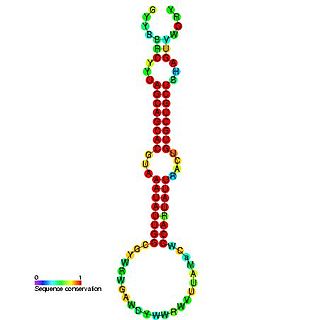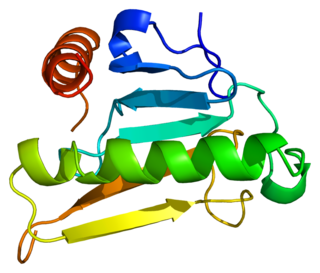T-cell leukemia/lymphoma protein 1A is a protein that in humans is encoded by the TCL1A gene. [5] [6] [7]
T-cell leukemia/lymphoma protein 1A is a protein that in humans is encoded by the TCL1A gene. [5] [6] [7]
TCL1A has been shown to interact with AKT1 [8] [9] [10] and AKT2. [8] [9]

The miR-16 microRNA precursor family is a group of related small non-coding RNA genes that regulates gene expression. miR-16, miR-15, mir-195 and miR-497 are related microRNA precursor sequences from the mir-15 gene family. This microRNA family appears to be vertebrate specific and its members have been predicted or experimentally validated in a wide range of vertebrate species.

The miR-17 microRNA precursor family are a group of related small non-coding RNA genes called microRNAs that regulate gene expression. The microRNA precursor miR-17 family, includes miR-20a/b, miR-93, and miR-106a/b. With the exception of miR-93, these microRNAs are produced from several microRNA gene clusters, which apparently arose from a series of ancient evolutionary genetic duplication events, and also include members of the miR-19, and miR-25 families. These clusters are transcribed as long non-coding RNA transcripts that are processed to form ~70 nucleotide microRNA precursors, that are subsequently processed by the Dicer enzyme to give a ~22 nucleotide products. The mature microRNA products are thought to regulate expression levels of other genes through complementarity to the 3' UTR of specific target messenger RNA.

The miR-29 microRNA precursor, or pre-miRNA, is a small RNA molecule in the shape of a stem-loop or hairpin. Each arm of the hairpin can be processed into one member of a closely related family of short non-coding RNAs that are involved in regulating gene expression. The processed, or "mature" products of the precursor molecule are known as microRNA (miRNA), and have been predicted or confirmed in a wide range of species.

T-cell acute lymphocytic leukemia protein 1 is a protein that in humans is encoded by the TAL1 gene.

RAC(Rho family)-alpha serine/threonine-protein kinase is an enzyme that in humans is encoded by the AKT1 gene. This enzyme belongs to the AKT subfamily of serine/threonine kinases that contain SH2 protein domains. It is commonly referred to as PKB, or by both names as "Akt/PKB".

Bis(5'-adenosyl)-triphosphatase also known as fragile histidine triad protein (FHIT) is an enzyme that in humans is encoded by the FHIT gene.

AKT2, also known as RAC-beta serine/threonine-protein kinase, is an enzyme that in humans is encoded by the AKT2 gene. It influences metabolite storage as part of the insulin signal transduction pathway.

NRAS is an enzyme that in humans is encoded by the NRAS gene. It was discovered by a small team of researchers led by Robin Weiss at the Institute of Cancer Research in London. It was the third RAS gene to be discovered, and was named NRAS, for its initial identification in human neuroblastoma cells.

RAC-gamma serine/threonine-protein kinase is an enzyme that in humans is encoded by the AKT3 gene.

The thrombopoietin receptor also known as the myeloproliferative leukemia protein or CD110 is a protein that in humans is encoded by the MPL oncogene.

Tyrosine-protein kinase receptor UFO is an enzyme that in humans is encoded by the AXL gene. The gene was initially designated as UFO, in allusion to the unidentified function of this protein. However, in the years since its discovery, research into AXL's expression profile and mechanism has made it an increasingly attractive target, especially for cancer therapeutics. In recent years, AXL has emerged as a key facilitator of immune escape and drug-resistance by cancer cells, leading to aggressive and metastatic cancers.

Mitogen-activated protein kinase kinase kinase 14 also known as NF-kappa-B-inducing kinase (NIK) is an enzyme that in humans is encoded by the MAP3K14 gene.

Tyrosine-protein kinase ABL2 also known as Abelson-related gene (Arg) is an enzyme that in humans is encoded by the ABL2 gene.

Cytoplasmic tyrosine-protein kinase BMX is an enzyme that in humans is encoded by the BMX gene.

Cyclin-C is a protein that in humans is encoded by the CCNC gene.

Arf-GAP with GTPase, ANK repeat and PH domain-containing protein 2 is a protein that in humans is encoded by the AGAP2 gene.

Protein p13 MTCP-1 is a protein that in humans is encoded by the MTCP1 gene.

T-cell leukemia/lymphoma protein 1B is a protein that in humans is encoded by the TCL1B gene.
In molecular biology, T-cell leukemia/lymphoma 6, also known as TCL6 is a long non-coding RNA. It is expressed in T-cell leukemia with a t(14;14)(q11;q32.1) chromosome translocation in humans and in a mouse model. It is not expressed in normal T-cells. It may be involved in leukemogenesis.

In molecular biology, TCL-1/MTCP-1 is a protein domain found in proteins encoded for by two related protooncogenes, other words by genes that help promote cancer. They are, T-cell leukemia/lymphoma protein 1A TCL1A encoded by oncogene TCL-1 SWISSPROT and Protein p13 MTCP-1 encoded by MTCP-1 SWISSPROT.